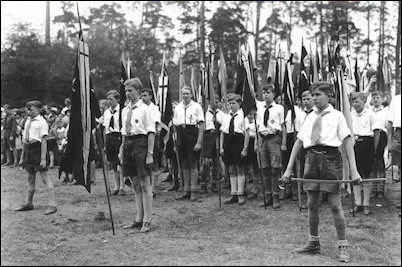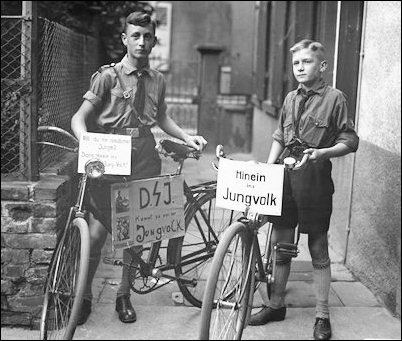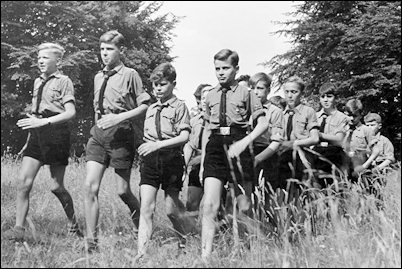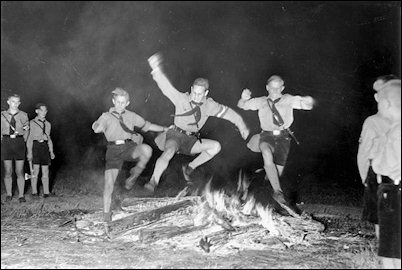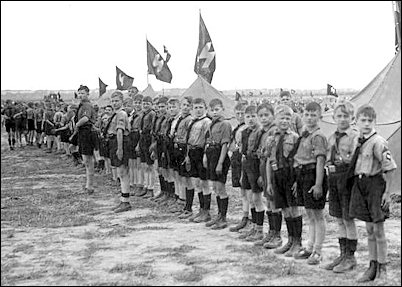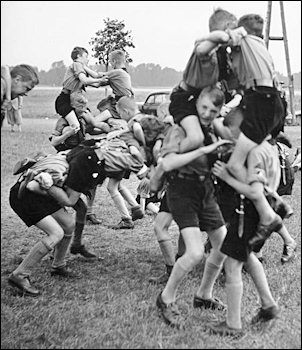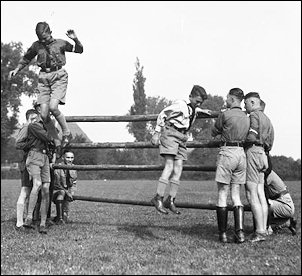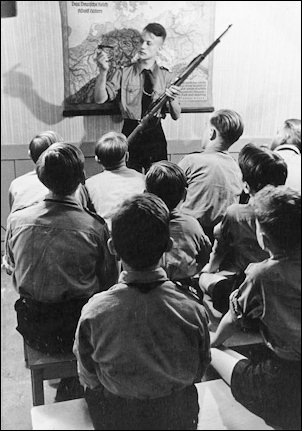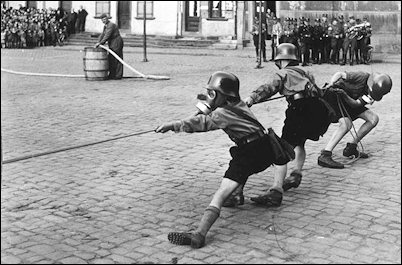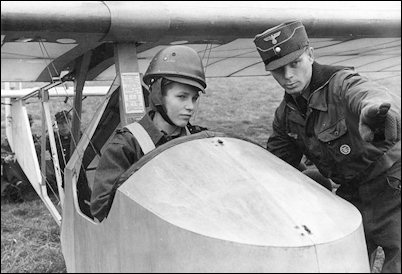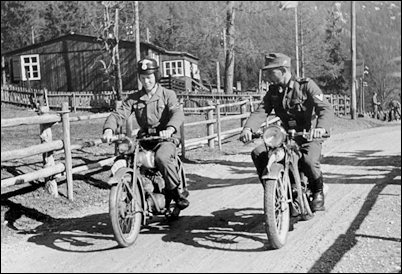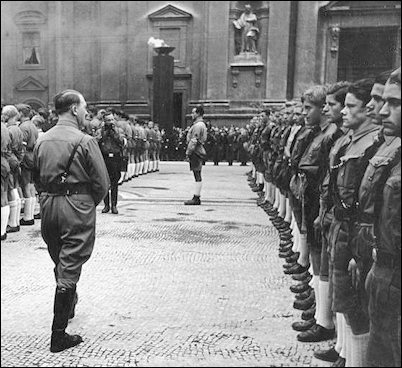![]()

Prelude to War
1933 - 1938
On the night of January 30, 1933, Nazis in Berlin celebrated the appointment of Adolf Hitler as Chancellor of Germany by conducting massive torchlight parades. Hitler Youth units were among those in the columns passing under the watchful gaze of Hitler and Paul von Hindenburg, the elderly president of Germany.
Within two months, Hitler acquired dictatorial powers resulting from the Enabling Act passed by the Nazi-controlled Reichstag. Hitler's acquisition of power meant the Hitler Youth and all other Nazi organizations now had the official power of the State on their side. The period of Nazi Gleichschaltung (forced coordination) immediately began in which all German institutions and organizations were either Nazified or disbanded. Hitler Youth Leader Baldur von Schirach now sought to eliminate all 400 of the other competing youth organizations, large and small, throughout Germany.
On April 3, 1933, Schirach sent fifty Hitler Youths storming into the Berlin offices of the Reichs Committee of German Youth Associations, an organization representing nearly six million German children involved a huge array of youth programs. Staff members inside the building were told to continue working and were simply informed they were now under the authority of the Hitler Youth. Thus the majority of Germany's youth organizations had instantly been placed under Schirach's control.
Many leaders among the conservative and nationalist youth groups willingly joined ranks with the Hitler Youth. Others, such as the Communist and Jewish youth organizations were quickly disbanded. Various Protestant groups were pressured by the Nazis to join and soon yielded. Offices of the Socialist Workers' Youth were also raided. Other groups were prevented from holding any gatherings by order of the police and Nazi storm troopers under the pretext of being a "public nuisance." Within months, most of the competing political and religious youth organizations in Germany vanished.
The only major holdout was the Catholic Youth Organization due in part to the international clout of the Church and an agreement (Concordat) that had been signed between the Vatican and Hitler's government protecting Catholic institutions in Germany. In Catholic sections of Germany, high ranking Nazis could still be found at Sunday mass along with groups of Hitler Youths in uniform and Hitler Youths serving at the altar wearing their uniforms beneath altar boy robes.
On June 17, 1933, Hitler promoted Schirach to Jugendführer des Deutschen Reiches (Youth Leader of Germany). Schirach was now answerable only to Hitler, with all youth activities in Germany placed under Schirach's sole command. In July, Schirach dissolved the old Reich's Committee of German Youth Associations since it no longer served any purpose.
Reorganization
Schirach soon introduced a new structure to the Hitler Youth based on age. Little boys aged 6 to 10 were allowed to hang around the older boys and participate informally. Boys 10 to 14 belonged to the Jungvolk, then from 14 to 18 were in the actual HJ, the commonly used abbreviation for Hitler Jugend (Hitler Youth). Each boy was given a performance booklet detailing his progress in athletics and Nazi indoctrination throughout all of his years in the HJ.
Girls 10 to 14 joined the Jungmädel and from 14 to 18 belonged to the BDM, the commonly used abbreviation for Bund Deutcher Mädel (League of German Girls). They wore a schoolgirl-style uniform with skirts and blouses along with army-style hiking boots.
However, the Hitler Youth organization was primarily male oriented and would remain so throughout the duration of the Third Reich, although the HJ and BDM did share common traits including a heavy emphasis on competition. Just about every task, no matter how big or small, was turned into an individual, team, or unit competition. This included boys and girls sports, the quality of singing during propaganda marches, and Winter Aid collections.
Boys and girls were kept constantly busy. The Nazis capitalized on the natural enthusiasm of young people, their craving for action and desire for peer approval, hoping that each young person would come to regard his or her HJ or BDM unit as a home away from home, or perhaps as their real home.
Activities for boys included vigorous games of hide and seek called "Trapper and Indian." They also played war games in which the boys formed platoons, put on red or blue arm bands, then were supposed to hunt down the "enemy" and rip off their arm bands. This sometimes resulted in fist fights and outright brawls between platoons. Younger, weaker boys got pummeled while platoon leaders stood by or even encouraged the fighting. Ripped shirts, scraped knees and elbows along with bruises were common during these field exercises which were intended to toughen them up.
Leadership Schools
By the end of 1933, the Hitler Youth organization had absorbed twenty German youth leagues and totaled over 3.5 million members, an enormous increase from a year earlier, before Hitler's acquisition of power, when it had numbered 107, 956. But this rapid increase also brought big problems, namely the lack of trained, politically reliable local youth leaders. New members absorbed from non-Nazi youth groups brought along non-Nazi sentiments and also struggled to adjust to the strict regimentation and tighter discipline of the Hitler Youth.
To resolve this problem, Reichsführer (leadership) schools were established throughout Germany offering three week cram courses on Nazi racial principles and German history along with practical leadership training, rigorous physical activity and rifle shooting. By August 1934, Schirach reported that over 12,000 Hitler Youth leaders and 24,000 Jungvolk leaders had completed these courses.
The Year of Training
Schirach labeled 1934 as "The Year of Training," and proclaimed during a speech: "Whoever marches in the Hitler Youth is not a number among millions but the soldier of an idea. The individual member's value to the whole is determined by the degree to which he is permeated by the idea. The best Hitler Youth, irrespective of rank and office, is he who completely surrenders himself to the National Socialist world view."
Vocational training was also emphasized as Schirach and Nazi labor leader Robert Ley initiated the annual National Vocational Competition for Hitler Youth in which teens learning various trades were judged and rewarded, with the winners in each category getting to meet Hitler.
In September 1934, the Hitler Youth made a notable appearance at the annual Nuremberg rally, an event well-documented in the propaganda film Triumph of the Will by Leni Riefenstahl. A ten-minute sequence shows Hitler's emotional appearance before the enthralled assembly inside the sports stadium amid frequent shouts of "Heil." In his speech he told them, "Regardless of whatever we create and do, we shall pass away, but in you, Germany will live on."
In October, amid the slogan "Blood and Soil," the Reich's Land Service was introduced, offering young city dwellers the opportunity to experience life on a German farm. All HJ and BDM members were expected to participate, helping to bring in the harvest, while learning the value of hard labor and the simple life.
Junior Gestapo Agents
An ominous new development within the HJ was the appearance of HJ-Streifendienst (Patrol Force) units functioning as internal political police, maintaining order at meetings, ferreting out disloyal members, and denouncing anyone who criticized Hitler or Nazism including, in a few cases, their own parents.
One case involved a teenager named Walter Hess who turned in his father for calling Hitler a crazed maniac. His father was then hauled off to Dachau under Schutzhaft (protective custody). For setting such an example, Hess was promoted to a higher rank within the HJ.
HJ-Streifendienst members also secretly infiltrated remnants of the old German Youth Movement and provided tips to the Gestapo which led to the arrest of several leaders of these now-clandestine youth groups.
During the 1934 Blood Purge, the top leadership of the SA was systematically murdered on Hitler's orders. The Nazis also used the occasion to settle old scores with a variety of political foes. Several former rival youth leaders were executed including Catholic Youth Leader Adalbert Probst who was "shot while trying to escape."
The close working relationship between the HJ-Streifendienst and the Gestapo aroused the attention of SS-Reichsführer Heinrich Himmler. Members of the HJ-Streifendienst were targeted for recruitment into the SS and proved to be very valuable additions. Many entered directly into SS officer training schools. Others joined the SS-Totenkopfverbände, the brutal Death's Head Brigades that operated Dachau and other concentration camps, and later ran the extermination centers in occupied Poland.
Bronze Over Brains
By 1935, about 60 percent of Germany's young people belonged to the Hitler Youth. Schirach declared it as "The Year of Physical Training" and introduced the second major annual HJ event – the Sports Competition. Medals were awarded to youths who performed rigorous athletic drills and met strict physical fitness standards. Every summer, a day would now be set aside as the "Day of the State Youth" for these events.
Physical fitness, according to Hitler, was much more important for his young people than memorizing "dead facts" in the classroom. In his book, Mein Kampf, he stated that "a less well-educated, but physically healthy individual with a sound, firm character, full of determination and willpower, is more valuable to the Volkish community than an intellectual weakling."
School schedules were adjusted to allow for at least one hour of physical training in the morning and one hour each evening. Prior to this, only two hours per week had been set aside. Hitler also encouraged young boys to take up boxing to heighten their aggressiveness.
Hitler believed tough physical training would instill confidence and that "this self-confidence must be instilled from childhood into every German. His entire education and training must be designed to convince him of his absolute superiority over others." Hitler viewed education as a means of raising nationalist enthusiasm in German boys while teaching them to be ready to sacrifice themselves for the Fatherland. Special assemblies were often held in school halls featuring themes of heroism and readiness to die for "the cause."
The Nazi Classroom
A portrait of Hitler hung in every classroom. Particular emphasis was paid to the subject of history, which was rewritten to emphasize Nazi themes of racial struggle and German pride. "It is the task of the racial state," Hitler declared, "to ensure that at long last world history will be written and that within its context the racial question will be elevated to the dominant position...so that a generation will emerge capable of facing the final and decisive decisions on this globe."
Hitler's life and struggle for power from 1918 to 1933 was emphasized, glorifying events such as the Beer Hall Putsch and offering hero-worship of Nazi figures such as Horst Wessel (a Berlin SA leader killed by Communists) along with Nazi mythology concerning Hitler's liberation of Germany from the "international Jewish/Bolshevik world conspiracy."
Racial indoctrination in the classroom included teaching young children how to spot a Jew by describing the physical traits which Nazis believed were associated with inferior peoples. In some classrooms, where Jews were still present, a Jewish child would be brought to the front of the class as an example. The teacher would then use a pointer, highlighting certain facial characteristics.
Hitler Youth songs also contained anti-Semitic lyrics including one song that said: "Yes, when the Jewish blood splashes from the knives, things will go twice as well."
In addition to the traditional German school system, the Nazis established three types of elite schools for the training of young Nazis: the Adolf Hitler Schools run by the Hitler Youth organization; the Napolas (National Political Institutes of Education) and the Ordensburgen (Order Castles) both run by the Nazi Party.
There were eventually ten Adolf Hitler Schools which took boys at age 12 from the Jungvolk and provided six years of intensive, highly disciplined leadership training under Spartan-like conditions, in place of a regular education. Top rated graduates of these schools were eligible for the exclusive Ordensburgen for another three years of training after which they would be ready to assume high level positions in the Nazi Party. It was from these Ordensburgen, steeped in Teutonic mythology, that Hitler hoped would emerge a "violently active, dominating, brutal youth...indifferent to pain, without weakness and tenderness."
Lowered Educational Standards
Throughout Germany, the entire teaching profession all the way up to university level had been purged of Jewish professors and anyone deemed politically unreliable regardless of their proven teaching abilities or achievements, including Nobel Prize recipients. Teachers who remained in the college classroom lived under the constant fear they might be denounced by one of their students and wind up in a concentration camp. This insecurity resulted in gross academic timidity which further lowered educational standards.
National Socialist teachers of questionable ability stepped into grammar school and high school classrooms to form young minds, strictly abiding by the Party motto: "The supreme task of the schools is the education of youth for the service of Volk and State in the National Socialist spirit." They taught Nazi propaganda as fact which was then recited back by their students as unshakable points of view with no room for disagreement or discussion.
Over the years, the Hitler Youth organization would gradually supplant the traditional elementary and secondary school system and become the main force educating German youth. And the quality of that education only got worse. Students emerging from the elite Adolf Hitler Schools were in superb physical condition and thoroughly drilled in Nazi ideology, but lacked basic skills in math and science. Biology, for example, had been completely corrupted to advance Nazi racial doctrine.
Under Hitler, a school system once among the finest in the world, became substandard almost overnight. Nazi scientists, educated before Hitler, would later complain they were partially hindered in developing new super weapons by the recruitment of young graduates from the elite Nazi schools.
In 1936, all of the Catholic parochial and Protestant denominational schools were abolished. Christian holy days which had usually meant a day off from school were now ignored and classroom prayers were banned. Celebrations of Christmas and Easter were discouraged, replaced by pre-Christian Yule or Solstice celebrations. The Nazis later forced all teachers to renounce any affiliation with professional church organizations.
Year of the Jungvolk
Schirach's goal in 1936 was to enroll the entire population of ten-year-olds throughout Germany into the Hitler Youth as a present for Hitler on his 47th birthday. Called "The Year of the Jungvolk," enormous pressure was put on young children to join. In school, they were pressured by Nazi-affiliated teachers. At home and at play, they were aggressively pursued by individual Hitler Youths and also through neighborhood propaganda marches, meetings for parents, and special children's sing-a-longs.
On April 20th, Hitler's birthday, a ceremony was held inside the ancient Marienburg Castle of the Teutonic Order. Amid the glow of torchlights, solemn beating of drums and fanfare of trumpets, ten-year-old boys entered the Jungvolk by swearing the following oath: "In the presence of this blood banner which represents our Führer, I swear to devote all my energies and my strength to the savior of our country, Adolf Hitler. I am willing and ready to give up my life for him, so help me God." This was followed by the singing of the Hitler Youth anthem, the Fahnenlied (Banner Song) written by Schirach.
After first joining the organization, the boys spent a few months on probation while undergoing training by older HJ members. A test was then given in which they had to recite all the verses of the Horst Wessel Song and answer basic questions concerning Hitler's life and the history of the Nazi Party. They also had to prove physical fitness by running 60 meters in twelve seconds, and take part in a cross country hike lasting a day and a half.
A Mutprobe (courage test) was then given such as jumping from a first or second story ledge into a large canvass held by older HJ. After passing all of the tests, each boy was entitled to wear the brown shirt bearing the Jungvolk insignia with a leather shoulder strap and the coveted Hitler Youth dagger bearing the inscription Blut und Ehre (Blood and Honor).
Mandatory Participation
On December 1st, 1936, Hitler decreed "The Law concerning the Hitler Youth" which mandated that all young Germans (excluding Jews) would "be educated physically, intellectually and morally in the spirit of National Socialism" through the Hitler Youth from the age of ten onward. This law also effectively ended the Catholic Youth Organization which had managed to hold out for three years amid constant Nazi harassment.
Parents who prevented their children from joining the Hitler Youth were subject to heavy prison sentences. Membership thus grew to nearly six million. As a result, the organization bloated into a giant bureaucracy in Berlin. It began to acquire the dreariness of a big governmental institution in marked contrast to the dynamic organization it had been in the 1920s and early '30s when members risked their lives daily to bring Hitler to power.
The compulsory nature of weekly HJ meetings for everyone also led to a gradual decline in morale and discipline. To add more excitement, a new phase began for the Hitler Youth with increased emphasis on paramilitary training in direct association with the Wehrmacht (Army), Luftwaffe (Air Force) and Navy. In 1937, a Hitler Youth rifle school was then established. About 1.5 million boys were trained in rifle shooting and military field exercises over the next few years with over 50,000 boys earning a marksmanship medal that required near perfect shooting at a distance of 50 meters (164 feet).
Special Hitler Youth paramilitary formations for boys eventually included: the Flieger-HJ in which aviation enthusiasts built gliders, participated in annual glider flying competitions, visited Luftwaffe facilities and went for rides in fighters and bombers; the Motor-HJ for boys 16 and older in which they acquired their driver's license and learned to ride motorcycles; and the Marine-HJ in which they obtained sailing certificates, learned river navigation, and participated in naval exercises aboard German training ships.
Hitler's Plan
In 1938, Hitler expanded Germany's borders by absorbing neighboring Austria and the Sudetenland (western portion of Czechoslovakia) with their large populations of ethnic Germans. As a result, Hitler Youth membership quickly swelled to 8.7 million.
In September, the last peacetime Nuremberg rally took place. It had the theme Grossdeutschland (Greater Germany) and was the largest one ever held, with nearly 700,000 members of various Nazi Party organizations participating during the week-long festival.
On Saturday, September 10th, over 80,000 Hitler Youths marched into the city stadium and performed military-style parade maneuvers which they had been practicing for an entire year, ending with a grand finale in which they spelled out the name 'Adolf Hitler' in the grandstand. After a tumultuous welcome, Hitler gave a speech in which he spoke candidly about his own youth and painful adolescence and then ended by telling them: "You, my youth, are our nation's most precious guarantee for a great future, and you are destined to be the leaders of a glorious new order under the supremacy of National Socialism. Never forget that one day you will rule the world!"
In November, Kristallnacht (the Night of Broken Glass) occurred in which Nazi storm troopers, the SS and Hitler Youths attacked Jews throughout the Reich. Police stood by and crowds watched as Jews were beaten while their shops and synagogues had their windows smashed and contents wrecked. Special pleasure was taken in the desecration of sacred religious scrolls. Over 25,000 Jewish men between the ages of 18 and 65 were hauled off to concentration camps.
Local Hitler Youths participated in the violence voluntarily but had not been officially instructed to do so. Schirach, on hearing of the extent of their participation, called a meeting of all high level group leaders and expressly forbade further participation in such "criminal actions."
But the violence was just beginning. Germany was on the path toward achieving Hitler's two main goals which he had outlined years earlier in Mein Kampf – the forced acquisition of living space to the east of Germany (resulting in World War II) and destruction of 'international Jewry' (resulting in the Holocaust).
Many Hitler Youths now regarded Hitler as their Führer-god and even recited pseudo-prayers to him such as: "Führer, my Führer, give me by God. Protect and preserve my life for long. You saved Germany in time of need. I thank you for my daily bread. Be with me for a long time, do not leave me, Führer, my Führer, my faith, my light, Hail to my Führer!"
Hitler, in a somewhat cynical mood in 1938, privately expressed his attitude toward them. "This youth learns nothing but to think German and to act German. When these boys enter our organization at the age of ten, it is often the first time in their lives that they get to breathe and feel fresh air; then four years later they come from the Jungvolk into the Hitler Youth, and we keep them there for another four years, and then we definitely don't put them back into the hands of the originators of our old classes and status barriers; rather we take them straight into the Party or into the Labor Front, the SA, or the SS, the NSKK [motorized corps] and so on. And if they are there for another two years or a year and a half and still haven't become complete National Socialists, then they go into the Labor Service and are polished for another six or seven months, all with a symbol, the German spade. And any class consciousness or pride of status that may be left here and there is taken over by the Wehrmacht for further treatment for two years, and when they come back after two, three, or four years, we take them straight into the SA, SS, and so on again, so that they shall in no case suffer a relapse, and they will never be free again as long as they live."
By early 1939, about 82 percent (7.3 million) of eligible youths within the Greater Reich belonged to the Hitler Youth, making it the largest youth organization in the world. A new law was issued on March 25, 1939, conscripting any remaining holdouts into the organization amid warnings to parents that their children would be taken from them and placed in orphanages unless they enrolled.
Soon, the entire organization would be shaken up from top to bottom, drawn into Hitler's new war, with consequences HJ members would never have imagined.
Copyright © 1999 The History Place™ All Rights Reserved
![]()
NEXT SECTION - Hitler's Boy Soldiers
The History Place - Hitler Youth Index Page
Terms of use: Private home/school non-commercial, non-Internet re-usage only is allowed of any text, graphics, photos, audio clips, other electronic files or materials from The History Place.
